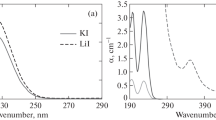Summary
Optimal condition were determined for the determination of ultramicroquantities of iodine by the Sandell-Kolthoff reaction. Solutions of 1.0M sodium chloride, 0.1N arsenic trioxide and 0.005N cericammonium sulphate in the ratio of As3+/Ce4+=20 were used. The optimum concentration of sulphuric acid in the reacting medium was found to be 2.5N. Justification was given for the use of an ice bath (+ 4° C) and of brucine to obtain a stable colour. Evidence is provided for the possibility of plotting the calibration curve from log extinction against iodine concentration.
Zusammenfassung
Die optimalen Bedingungen für die Bestimmung von Ultramikromengen Jod mit Hilfe der Sandell-Kolthoff-Reaktion wurden ausgearbeitet. 1-m Natriumchloridlösung sowie 0,1-n arsenige Säure und 0,005-n Cer-Ammonium-sulfatlösung werden im Verhältnis As3+: Ce4+=20 verwendet. Das Reaktionsgemisch soll an Schwefelsäure am besten 2,5-n sein. Die Verwendung eines Eisbades (+ 4° C) und von Brucin zur Erzielung einer konstanten Farbe wird begründet. Die Möglichkeit der Ermittlung einer Eichkurve durch Auftragung des Logarithmus der Extinktion gegen die Jodkonzentration wird gezeigt.
Résumé
On a mis au point les conditions optimales du dosage de quantités d'iode à l'échelle ultramicro par la réaction deSandell etKolthoff. On a utilisé des solutions de chlorure de sodium 1,0 M, d'anhydride arsénieux 0,1N et de sulfate de cérium et d'ammonium 0,005N dans le rapport As3+/Ce4+=20. On a trouvé que la concentration optimale en acide sulfurique dans le milieu réagissant était de 2,5N. On a justifié l'emploi d'un bain de glace (+ 4° C) et de la brucine pour l'obtention de la stabilité de la couleur. On a montré la possibilité de construire la courbe d'étalonnage à partir de la densité optique au lieu de la concentration en iodure.
Similar content being viewed by others
References
E. B. Sandell andI. M. Kolthoff, Mikrochim. Acta1, 9 (1937).
K. Rodgers andD. B. Poole, Biochem. J.70, 463 (1958).
O. Bodanshy, R. S. Benua, andG. Pennacchia, Amer. J. Clin. Path.30, 375 (1958).
H. Spitzy, M. Reese, andH. Skrube, Mikrochim. Acta [Wien]1958, 488.
V. Štole, Probl. Endokrinol. (Moscow) (in the press).
S. Glasstone, Textbook of Physical Chemistry, 2nd (British) ed. London: Macmillan. pp. 1087, 1141.
N. E. Kontaxis andD. E. Pickering, J. Clin. Endocrinology18, 774 (1958).
H. L. Thompson, M. R. Klugerman, andJ. Truemper, J. Lab. Clin. Med.47, 149 (1956).
J. D. Acland, Biochem. J.66, 177 (1957).
L. W. O'Neal andE. S. Simms, Tech. Bull. Reg. Med. Technologists23, 75 (1953).
R. D. Strickland andC. M. Maloney, Analyt. Chemistry29, 1870 (1957).
A. Lein andN. Schwartz, Analyt. Chemistry23, 1507 (1951).
A. Grossmann andG. F. Grossmann, J. Clin. Endocrinology15, 354 (1955).
R. J. Magee andH. Spitzy, Mikrochim. Acta [Wien]1959, 101.
J. Fischl, Clin. Chim. Acta1, 462 (1956).
Author information
Authors and Affiliations
Rights and permissions
About this article
Cite this article
Štolc, V. Optimal conditions for the catalytic action of iodine in the Sandell-Kolthoff reaction. Mikrochim Acta 49, 710–720 (1961). https://doi.org/10.1007/BF01217356
Received:
Issue Date:
DOI: https://doi.org/10.1007/BF01217356



